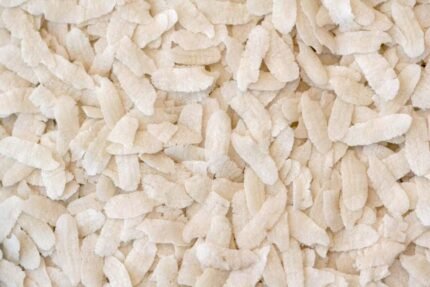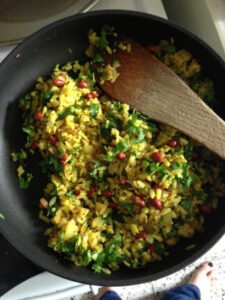Medically reviewed by Dr. Ramesh Gaddam, M.D. — Written by Sumalatha, D.N.H.E
Table of Contents
TogglePoha, a popular Indian breakfast made from flattened rice, is both tasty and healthy. Packed with essential vitamins and minerals, poha can help with digestion and provide a good energy boost. By including poha in your diet, you can enjoy a simple meal that supports your overall health. Let’s look at the ways poha can be beneficial for you.
1. Poha Nutrition
The nutritional profile of poha (per 100 grams):
| Nutrient | Amount |
|---|---|
| Calories | 76 kcal |
| Carbohydrates | 15.8 g |
| Protein | 2 g |
| Fat | 0.9 g |
| Fiber | 1.2 g |
| Vitamin A | 0 IU |
| Vitamin C | 0 mg |
| Calcium | 18 mg |
| Iron | 0.5 mg |
| Potassium | 80 mg |
Aids Digestion:
Poha is easy on the stomach and promotes smooth digestion due to its high fiber content. The soft texture of poha helps in breaking down food more efficiently, which can reduce bloating and discomfort.
Including poha in your diet can aid in maintaining a healthy digestive system, ensuring regular bowel movements and overall digestive health.
Boosts Energy Levels:
Poha is a great source of carbohydrates, providing a quick and sustained energy boost. It replenishes glycogen levels in the body, which helps to maintain energy throughout the day.
Eating poha for breakfast can keep you energized and alert, making it an ideal choice for starting your day.
Supports Weight Management:
Low in calories and high in fiber, poha can be a helpful component of a weight management plan. The fiber content keeps you feeling full longer, reducing the likelihood of overeating.
Its balanced nutrient profile ensures you get essential vitamins and minerals while controlling calorie intake.
Provides Essential Vitamins and Minerals:
Poha is rich in important nutrients such as iron, calcium, and vitamin B complex. These nutrients support various bodily functions, including bone health, energy production, and red blood cell formation.
Incorporating poha into your diet can help meet your daily nutritional needs.
Promotes Heart Health:
Poha is low in fat and contains heart-healthy nutrients like potassium, which helps regulate blood pressure. Its antioxidant properties can reduce oxidative stress and inflammation, supporting overall cardiovascular health.
Regular consumption of poha can contribute to a healthier heart and lower the risk of heart disease.
Improves Skin Health:
The vitamins and minerals in poha, such as iron and B vitamins, play a role in maintaining healthy skin. Iron helps improve blood circulation, while B vitamins support skin cell regeneration.
Eating poha can contribute to a glowing complexion and overall skin health.
Regulates Blood Sugar Levels:
Poha has a low glycemic index, which means it helps maintain stable blood sugar levels. The complex carbohydrates in poha release energy slowly, preventing spikes in blood sugar.
This makes it a suitable option for people with diabetes or those looking to manage their blood sugar levels.
Enhances Overall Vitality:
With its combination of essential nutrients and easy digestibility, poha can enhance overall vitality and well-being. It provides a balanced source of energy, supports various bodily functions, and helps maintain good health.
Including poha in your diet can contribute to feeling more active and vibrant.
3. Poha Uses
Poha is a versatile ingredient used in a variety of dishes across different cuisines.
Traditionally enjoyed as a breakfast staple in India, it can be prepared in numerous ways to suit diverse tastes. Poha can be flavored with spices, vegetables, and herbs to create a savory meal, or it can be sweetened and mixed with fruits for a delightful snack.
Additionally, poha is used in salads and snacks, offering a crunchy texture and nutty flavor. Its adaptability makes it a convenient and healthy choice for a range of culinary applications.
4. Poha Side Effects
Digestive Issues
Overconsumption of poha can cause digestive discomfort, such as bloating, due to its fiber content. It’s important to consume it in moderation and balance it with other foods to avoid digestive problems.
Allergic Reactions
Some individuals may experience allergies or sensitivities to ingredients used in poha, though this is rare. If you notice any unusual symptoms, it’s best to consult a healthcare provider.
High Sodium
If poha is prepared with excessive salt or pickles, it can lead to high sodium intake, potentially affecting blood pressure. Opt for low-sodium seasoning to keep it heart-healthy.
Weight Gain
Eating large amounts of poha, especially with high-fat ingredients, can contribute to weight gain. Moderation and a balanced diet are key to enjoying poha without adding excess calories.
Blood Sugar Impact
While poha has a low glycemic index, excessive consumption or pairing it with sugary foods can impact blood sugar levels. Balance it with proteins and vegetables to maintain stable glucose levels.
5. Poha Calories
Poha contains approximately 76 calories per 100 grams. This calorie count can vary slightly based on preparation methods and added ingredients.
Despite its relatively low calorie content, poha provides essential nutrients and energy, making it a balanced choice for a meal.
6. Is poha good to eat daily?
Yes, poha can be a good choice to eat daily, provided it is part of a balanced diet. It offers essential nutrients like carbohydrates, iron, and vitamins, and is easy to digest.
However, it’s important to prepare it with healthy ingredients and control portion sizes.
Incorporating a variety of foods and nutrients ensures a well-rounded diet and helps avoid potential issues like nutrient imbalances or excessive calorie intake.
7. Is Poha high in protein?
No, poha is not particularly high in protein. It contains about 2 grams of protein per 100 grams, which is relatively low compared to other protein-rich foods.
While poha is a good source of carbohydrates and provides some essential nutrients, it’s beneficial to combine it with other protein-rich foods like legumes, yogurt, or nuts to meet your daily protein needs.
Frequently Asked Questions (FAQs)
Is poha heavy to digest?
No, poha is generally not heavy to digest. Its soft, flattened rice texture makes it easy on the stomach, and it can aid in digestion due to its fiber content.
Is poha a junk food?
No, poha is not considered junk food. It is a nutritious, traditional dish that provides essential nutrients and can be part of a healthy diet when prepared with wholesome ingredients.
Which is better, rice or poha?
Both rice and poha have their benefits. Poha is often easier to digest and can be lower in calories and fat compared to cooked rice. However, rice provides more protein and can be a better option for certain dietary needs.
Is poha good for belly fat?
Poha can be beneficial for managing belly fat when consumed in moderation as part of a balanced diet. Its low calorie and fiber content help in feeling full, potentially reducing overall calorie intake.
Is poha healthier than roti?
Both poha and roti have health benefits, but their nutritional profiles differ. Poha is lower in calories and fat, while roti provides more fiber and protein. Choosing between them depends on your dietary needs and preferences.
Is poha a superfood?
Poha is not typically classified as a superfood, but it is a nutritious and healthful option. It offers essential vitamins, minerals, and carbohydrates, making it a beneficial addition to a balanced diet.
Also Read:
Medically reviewed by Dr. Ramesh Gaddam, M.D.

General Physician, Diabetologist, and Critical Care Specialist.
Related
Discover more from Health Build-Up
Subscribe to get the latest posts sent to your email.



